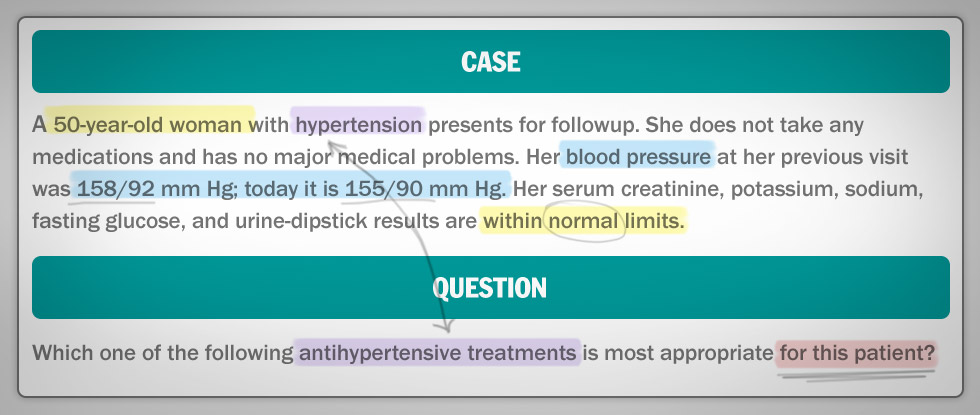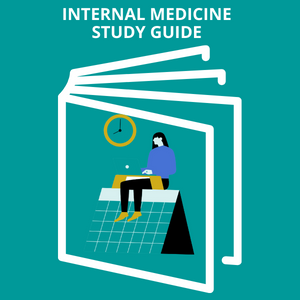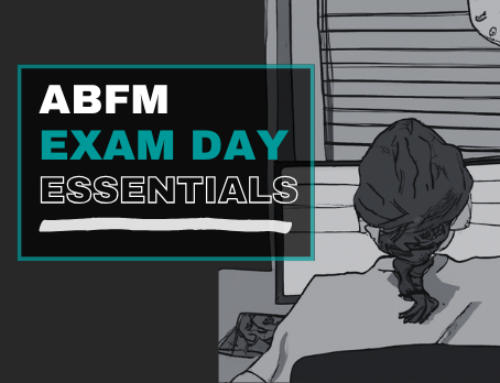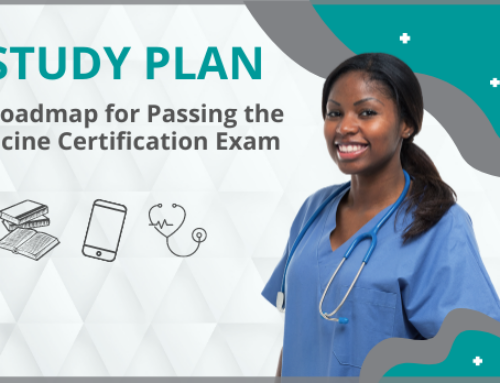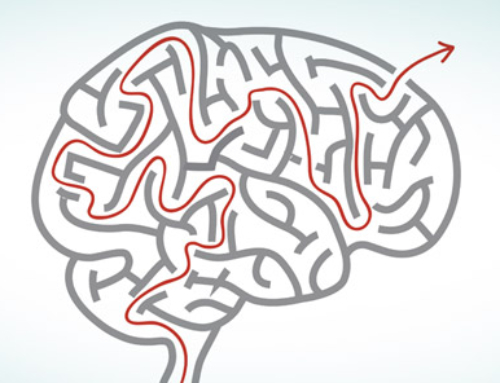ABIM questions can pose challenges for almost any test taker, even those who are highly experienced. With only two minutes on average to answer each question, you’ll need to make the most of your time and knowledge to pass the ABIM exam. This post will help you sharpen your approach to ABIM board questions so you can tackle the Internal Medicine exam with confidence.
ABIM Exam Format
The ABIM exam format consists of 240 case-based, multiple-choice questions each having a single best answer. The test is broken into four sessions with sixty (60) questions each. Exams, which take place at Pearson Testing centers, are “open book,” meaning examinees are given access to an external digital reference. ABIM scores every question, so it is important to answer as many as you can. If, after you follow the steps outlined below, you still don’t know the answer to a question, rather than leave it blank, apply the elimination strategy: Narrow down the options until you are left with the most plausible or best-guess choices and then take a guess. That way you at least have a better-than-none chance of scoring for that question.
ABIM Board Questions
The majority of ABIM board questions are case-based scenarios that require reasoning and decision-making. Each question has three distinct parts:
- The patient vignette or question scenario that usually includes demographic information and describes the patient’s presenting symptoms
- The lead-in or the question itself
- The answer options, including one correct answer and several distractors that may be partially correct
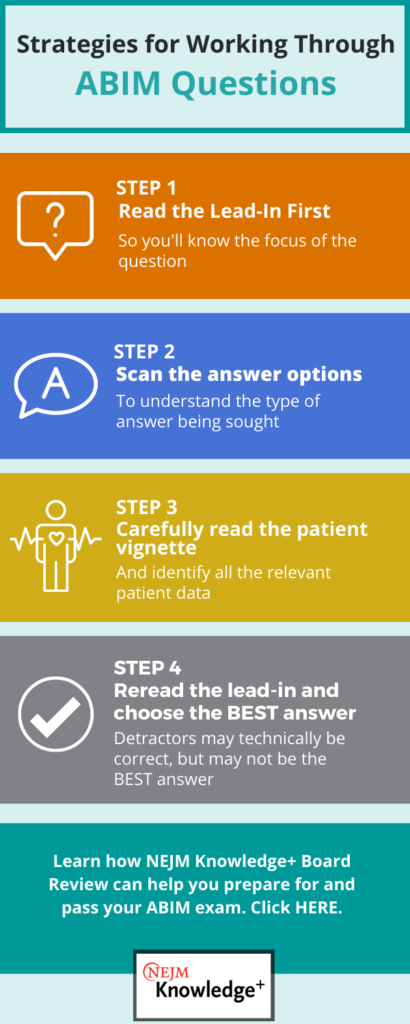 Steps for Answering ABIM Exam Questions
Steps for Answering ABIM Exam Questions
Common advice for multiple-choice tests often suggests covering the answers and mentally forming an answer before looking at the possible choices. This is a good study strategy because it leverages the power of the Testing Effect: The act of retrieving knowledge from your memory reinforces learning and strengthens neural connections, enhancing later recall.
But for ABIM exam questions, the “cover test” approach is not a good use of your time. Instead, it is best to approach each Internal Medicine board question in this order:
- Read the lead-in first to understand the focus of the question.
- Scan the answer options to gauge what type of answer is being sought.
- Read the patient vignette carefully and consider all the data in the patient scenario
- Reread the lead-in and choose the BEST answer.
This sequence sets you up to approach the patient vignette with a goal in mind so as you read patient characteristics, review laboratory test results, and view images, you can mentally sort the information according to what the question is asking — be it a diagnosis, a treatment, or the best next diagnostic test.
Following the steps in this order will help you quickly recognize the essential cues within each part of the question and then apply specific strategies that will lead you to the correct answer. Let’s look at each step more closely:
1. Read the lead-in first to understand the focus of the question
When you approach a question, you’ll be tempted to read the clinical vignette first, but start with the lead-in and pay very close attention to what it asks. Usually, it will ask for “the best next step” or “the most likely diagnosis” — and this should be your focal point as you move through the rest of the question.
Practice these steps and perfect your strategies for tackling ABIM board questions with NEJM Knowledge+ Internal Medicine Board Review — the largest, most comprehensive Internal Medicine question bank available.
 2. Scan the answer options to gauge what type of answer is being sought
2. Scan the answer options to gauge what type of answer is being sought
Reading the lead-in and then reviewing the answer options will key you into relevant details as you read the patient vignette.
But don’t simply scan an ABIM exam question before answering. A test taker’s biggest mistake is jumping to a conclusion after seeing a buzzword. For example, when you see the term “pill-rolling tremor,” your mind makes the association with Parkinson’s disease, but the correct answer may be about something quite different. Some questions test whether you can recognize the exception rather than the rule.
Avoid Mental Shortcuts
When preparing for the Internal Medicine exam, train your mind to avoid mental shortcuts. And during the exam, pay attention to what is really being asked — rather than to any shortcut your mind might be taking.
Train your brain to avoid mental shortcuts with NEJM Knowledge+ Internal Medicine Board Review. As you answer questions in NEJM Knowledge+, you’ll be asked to evaluate how confident you are about your answers. This challenges you to “think about your thinking,” which, in turn, strengthens your metacognition. Metacognition is key not only to avoiding mental shortcuts, but also to the higher order thinking you’ll need to answer ABIM questions successfully, pass your exam, and practice medicine effectively.
ABIM certification and recertification exams are not intended to identify the top 10% of test takers or shave off the bottom 10%. Their goal is to test for a base level of competence according to a standard that has been set by the writers and the board. Testing to a standard requires questions that range in difficulty. So, some questions will seem easy. If you’ve read the question carefully and know the topic, your first instinct may indeed be correct. You need not second-guess yourself.
 If careful reading and reflection (next step below) cause you to veer from your initial instinct, it’s perfectly fine to change your answer. This advice may run contrary to what you heard decades ago. But evidence has shown that in high-stakes medical exams, changing answers upon reflection can be the correct course.
If careful reading and reflection (next step below) cause you to veer from your initial instinct, it’s perfectly fine to change your answer. This advice may run contrary to what you heard decades ago. But evidence has shown that in high-stakes medical exams, changing answers upon reflection can be the correct course.
3. Read the patient vignette carefully and isolate all the relevant data in the patient scenario.
Patient vignettes contain little extraneous data, so anything beyond basic patient characteristics warrants notice. A question writer typically starts with a “testing point” and then builds the question to address it. Nearly every vignette includes vital signs, physical exam results, and a few other details to make the case patient realistic. These basic patient characteristics often set the stage rather than offer significant clues to the correct answer.
Good question writers avoid red herrings. Questions typically aim for brevity and include only those lab results or pieces of history and psychosocial information that relate to the answer. New symptoms, recent diagnoses, and the timing of symptom progression should all be taken into account. If family history is mentioned, pay attention to it. Look carefully at all photographs, radiographs, CT scans, and electrocardiograms — each is included for a reason.
Perfect your ability to carefully read patient vignettes and identify relevant details with NEJM Knowledge+ Internal Medicine Board Review, which has over 5,100 questions, all mapped to the ABIM blueprint, including case-based, multiple-choice patient vignette questions just like the ones you’ll encounter on the exam.
4. Reread the lead-in and choose the BEST answer.
In some questions, more than one answer could be correct, but remember, you are being asked for the best answer, not simply any plausibly correct answer. To reach the best answer, you may need to draw upon both knowledge and higher-order decision-making.
And it’s easy to make mistakes. A good question writer finds distractors that are plausible but not the best answer for the particular scenario. A hasty question reader will fall for a good distractor.
Internal Medicine Board Questions: Two Cognitive Steps to Reach the Right Answer
Internal Medicine board questions call for advanced reasoning and often require more than one cognitive step to reach the correct answer. Typically, a question requires that you first make a correct diagnosis and then go further to infer the best next step.
 For example, if a vignette describes a patient with elevated levels of both parathyroid hormone and calcium, it would be too simple to ask only, “What is the most likely diagnosis?” The more likely question is, “What is the most appropriate next step in care for this patient?” Rather than be tempted to do additional laboratory testing, you would be expected to use the existing results to correctly recognize primary hyperparathyroidism, anticipate that surgery is likely to be needed, and that localization imaging should generally precede the surgery.
For example, if a vignette describes a patient with elevated levels of both parathyroid hormone and calcium, it would be too simple to ask only, “What is the most likely diagnosis?” The more likely question is, “What is the most appropriate next step in care for this patient?” Rather than be tempted to do additional laboratory testing, you would be expected to use the existing results to correctly recognize primary hyperparathyroidism, anticipate that surgery is likely to be needed, and that localization imaging should generally precede the surgery.
For the purposes of the test, you are not expected to know the complete range of steps and options progressing into the patient’s future, but the exam will challenge you to infer the best next step in the context of the given scenario. As you prepare for boards, training your mind to make this second cognitive step will help you focus on what the question is asking.
Focus on Resource Utilization and Relevance in Today’s Internal Medicine Board Exam
As you consider the answer to a question, keep in mind the matter of resource utilization. Good test questions now ask about best practices, which can include your use of resources. ABIM’s interest in resource utilization, may be reflected in test questions.
Tie All These Strategies Together for ABIM Board Exam Success
There is no single approach to test taking that will guarantee a successful outcome, but the strategies we’ve outlined here — reading the question elements carefully in a certain sequence, being aware of mental shortcuts, and being prepared to make more than one cognitive step — will all improve your likelihood of success.
NEJM Knowledge+ Internal Medicine Board Review centers on our adaptive learning algorithm that delivers questions to you in intervals that promote long-term retention. The program tests your knowledge in different contexts and question formats so you develop the deep, intrinsic understanding you’ll need when answering the case-based, patient-vignette questions you’ll see on the ABIM exam. NEJM Knowledge+ will never waste your valuable time on questions about topics you’ve already mastered. Instead, it will save you countless hours by tailoring your learning experience in real-time to create the most efficient, effective learning experience for you.
Additional ABIM Exam Resources
- ABIM practice exam
- ABIM blueprint
- Board Exam Study Group Guide
- Board Review Courses
- Survival Guide ABIM Exam Day
- Personalized Study Guide
If you have an ABIM certification or recertification exam coming up, check out our Ultimate Internal Medicine Study Guide. You’ll find lots of great information and resources to help you prepare and pass!


